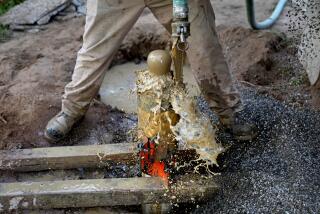Southland Water Supply
I read with anger the column by Carl Boronkay (“Sky Is Not Falling, as Our Water Level Attests,” Op-Ed Page, April 3). His attitude typifies the short-sighted environmental, political and social consciousness which characterizes Southern California. Has it ever occurred to Boronkay or anyone living in Los Angeles, the largest desert city in the world, that the continued push for growth and development is, perhaps, absurd?
When the average glass of water has its origins some several hundred miles away--and by the time it gets here, it is undrinkable--perhaps we should begin to question the sanity of those who, to this day, encourage the relentless growth of the region at the expense of the environmental and social well-being of not just Southern California, but of the entire Western United States (as L.A. is utterly dependent on Northern California, Colorado, Utah and eventually perhaps Oregon, Washington and even Canada for its supply of water and energy).
For nearly 100 years, many of the public officials and private citizens in positions of power (from Fred Eaton and William Mulholland to the present) have been involved in the development of water projects, which if not illegal, are certainly the result of activities of dubious moral quality. It has been land grabs, land purchasing schemes and speculation which has fueled the growth of the Los Angeles basin. No region on the planet can approach Los Angeles in its effort to alter the limitations of the natural environment.
Finally, perhaps the economics of past, current and future water projects should be examined. Given that new water projects directly benefiting Metropolitan Water District customers would be financed by and large by those customers, perhaps those customers of MWD should ponder the following: Had Senate Bill 200 been ratified by the voters of California in 1982 and the Peripheral Canal been built, the cost burden to the residents of Southern California would have been staggering.
Using simple arithmetic, one would divide the number of MWD customers into the $11.6 billion that the project was supposed to cost (a low estimate), multiply that by .7 (70% of the cost would be financed by MWD customers) and come up with a figure of $3,000.
As the quality of life continues to deteriorate as a result of uncontrolled development and a continued population explosion, perhaps the residents of Southern California should begin to ponder when--and where--the insanity will end.
CARTER C. BRAVMANN
Los Angeles
More to Read
Sign up for Essential California
The most important California stories and recommendations in your inbox every morning.
You may occasionally receive promotional content from the Los Angeles Times.










